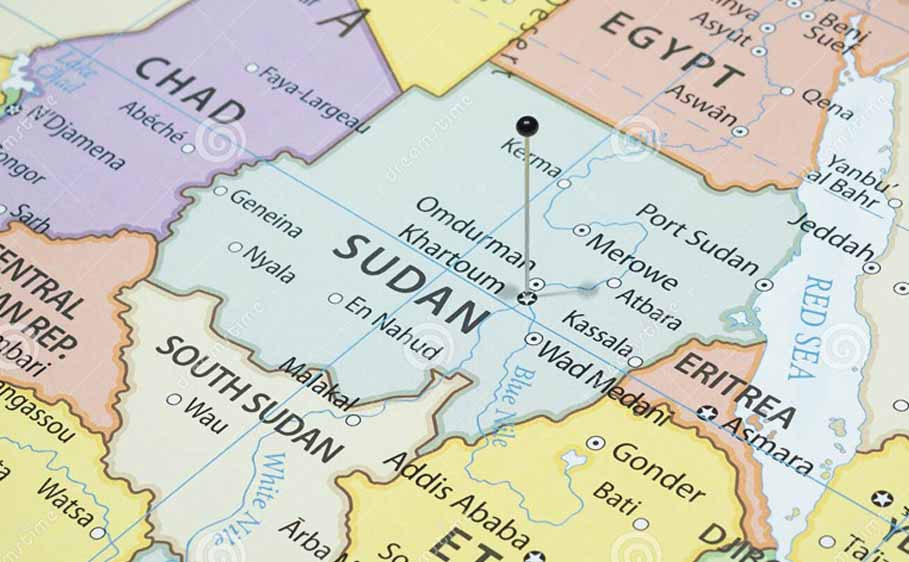
The Name
The country’s name Sudan is a name given historically to the large Sahel region of West Africa to the immediate West of modern day Sudan. Historically, Sudan referred to both the geographical region, stretching from Senegal on the Atlantic Coast to north-eastern Africa and the Republic of Sudan. The name derives from the Arabic bilād as-sūdān (بلاد السودان), or “The Land of the Blacks”. The name is one of various toponyms sharing similar etymologies, in reference to the more or less dark skin of the inhabitants. Prior to this, Sudan was known as Nubia and Ta Nehesi or Ta Seti by Ancient Egyptians named for the Nubian and Medjay archers or Bow men.
The Country
Sudan (English: /suːˈdɑːn/ or /suːˈdæn/; Arabic: السودان, romanized: as-Sūdān), officially the Republic of the Sudan (Arabic: جمهورية السودان, romanized: Jumhūriyyat as-Sūdān), is a country in Northeast Africa. It shares borders with the Central African Republic to the southwest, Chad to the west, Egypt to the north, Eritrea to the northeast, Ethiopia to the southeast, Libya to the northwest, South Sudan to the south and the Red Sea. It has a population of 45.70 million people as of 2022 and occupies 1,886,068 square kilometres (728,215 square miles), making it Africa’s third-largest country by area, and the third-largest by area in the Arab League. It was the largest country by area in Africa and the Arab League until the secession of South Sudan in 2011, since which both titles have been held by Algeria. Its capital is Khartoum and its most populated city is Omdurman (part of the metropolitan area of Khartoum).
Geography
Sudan is situated in North Africa, with an 853 km (530 mi) coastline bordering the Red Sea.[158] It has land borders with Egypt, Eritrea, Ethiopia, South Sudan, the Central African Republic, Chad, and Libya. With an area of 1,886,068 km2 (728,215 sq mi), it is the third-largest country on the continent (after Algeria and Democratic Republic of the Congo) and the fifteenth-largest in the world.
Sudan lies between latitudes 8° and 23°N. The terrain is generally flat plains, broken by several mountain ranges. In the west, the Deriba Caldera (3,042 m or 9,980 ft), located in the Marrah Mountains, is the highest point in Sudan. In the east are the Red Sea Hills.
The Blue Nile and White Nile rivers meet in Khartoum to form the Nile, which flows northwards through Egypt to the Mediterranean Sea. The Blue Nile’s course through Sudan is nearly 800 km (497 mi) long and is joined by the Dinder and Rahad Rivers between Sennar and Khartoum. The White Nile within Sudan has no significant tributaries.
There are several dams on the Blue and White Niles. Among them are the Sennar and Roseires Dams on the Blue Nile, and the Jebel Aulia Dam on the White Nile. There is also Lake Nubia on the Sudanese-Egyptian border.
Rich mineral resources are available in Sudan including asbestos, chromite, cobalt, copper, gold, granite, gypsum, iron, kaolin, lead, manganese, mica, natural gas, nickel, petroleum, silver, tin, uranium and zinc
Climate
The amount of rainfall increases towards the south. The central and the northern part have extremely dry, desert areas such as the Nubian Desert to the northeast and the Bayuda Desert to the east; in the south, there are grasslands and tropical savanna. Sudan’s rainy season lasts for about four months (June to September) in the north, and up to six months (May to October) in the south.
The dry regions are plagued by sandstorms, known as haboob, which can completely block out the sun. In the northern and western semi-desert areas, people rely on the scant rainfall for basic agriculture and many are nomadic, travelling with their herds of sheep and camels. Nearer the River Nile, there are well-irrigated farms growing cash crops.[161] The sunshine duration is very high all over the country but especially in deserts where it could soar to over 4,000 h per year.
Environmental issues
Desertification is a serious problem in Sudan. There is also concern over soil erosion. Agricultural expansion, both public and private, has proceeded without conservation measures. The consequences have manifested themselves in the form of deforestation, soil desiccation, and the lowering of soil fertility and the water table.
The nation’s wildlife is threatened by poaching. As of 2001, twenty-one mammal species and nine bird species are endangered, as well as two species of plants. Critically endangered species include: the waldrapp, northern white rhinoceros, tora hartebeest, slender-horned gazelle, and hawksbill turtle. The Sahara oryx has become extinct in the wild.
Capital
Khartoum
Official languages
Arabic and English
Currency
Sudanese pound (SDG)
Time zone
UTC+2 (CAT)
Electricity
200 Volts (220) 50Hz.
Driving side
right
Calling code
+249